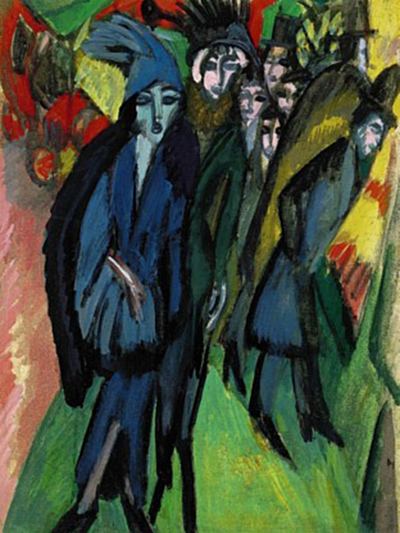Street Scene is another example of Kirchner's work depicting the chaos, as he saw it, of city life. This series is regarded as one of the most important contributions to the overall German Expressionist movement.
The artist's Expressionist style would produce portraits of a near-ghostly appearance. There is a similarity to some of Munch's work in Norway, and in Kirchner's city scenes he was attempting to produce an atmosphere of chaos and loneliness. He used city life as an inspiration for perhaps his most significant series of work, but was clearly far from happy to be in this frenetic environment. Much of his work focused on the night life and seedier side of the city, capturing street scenes of prostitutes with their customers and pimps. That said, he always portrayed the women in relatively positive ways, dressed elegantly and seemingly confident and very much desired by the non-descript customers who float around in the background.
It is the women who would be closest to the viewer, often sporting delicate hats and long elegant dresses beneath coats. Their figures would be encased in dark lines, as the artist did with all of his portraits. He would combine dark and light tones to produce huge contrasts which drew attention to the eye immediately. There are elements of the street in the background but they are not given much detail, making them hard to precisely decipher and are more there to just suggest at a setting rather than lay it out exactly as in reality. In contrast to the darker tones of black and blue, he livens up the piece with green, pink, red and yellow.
His series of work on this theme took in both the streets of Berlin but also Dresden several years later. Some of the highlights included Berlin Street Scene, Street, Berlin and Street, Dresden. He did not give particularly imaginative names to these pieces, preferring just to present them as unspecific representations of life in Germany's larger cities. One can understand from these portraits that he enjoyed life in the countryside more and would go onto to produce large numbers of more upbeat landscape paintings. The combination of the two provide an interesting comparison of his overall career oeuvre.
Street Scene is also sometimes known as Straßenszene Berlin and was specifically produced in 1913 at a time when the artist was experimenting with his expressive portraiture, with a particular focus on outdoor life in the cities of Germany, with a number of other notable pieces also arriving along similar lines. This artwork measures 70cm by 50cm, approximately, and is now owned and displayed by the Art Gallery of Ontario, Toronto which is an important institution which specialises in contemporary painting and sculpture from Europe and North America. Although there are many thousands of items to enjoy here, some of the highlights include pieces from famous artists such as Constantin Brâncuși, Marc Chagall, Otto Dix, Henri Matisse, Fernand Léger, Joan Miró, Amedeo Modigliani, Claude Monet and Yves Tanguy.




